Mercury Legacy Products – Novelty Items
Jewelry
Description:
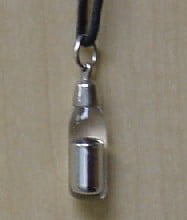
Certain necklaces, particularly those imported from Mexico, may contain liquid elemental mercury. These necklaces often consist of a beaded chain, cord, or leather strand with a glass pendant or ampoule that contains the elemental mercury. The mercury appears as a silvery clump of liquid that rolls around in the hollow glass pendant. The necklaces contain between three and five grams of elemental mercury. In addition to the mercury, the pendant may also be filled with brightly colored liquids (i.e., red, green, blue, yellow). The pendants can come in various shapes and designs, including hearts, bottles, balls, saber teeth, and chili peppers.
Purpose of the Mercury:
The elemental mercury contained in necklaces, pendants, and other jewelry is mainly for ornamental purposes, but sometimes has cultural or religious significance.
Potential Hazards:
Mercury may be released from these necklaces when the glass pendant is broken or when it leaks around the pendant’s cord anchor. If a leak or break occurs, persons should immediately contact their state environmental agency for instructions on proper clean-up and disposal. They should contact their public health department or poison control center if they have been exposed to the mercury.
Recycling/Disposal:
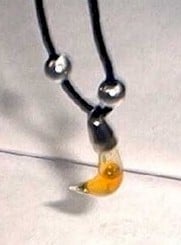
Many states offer household hazardous waste collection programs for recycling and disposal of mercury-containing items, including necklaces. Some states and municipalities provide this service free of charge, while others require a small fee. Persons should first check with their local municipality to find out about the specific recycling and disposal options (including which products are accepted).
Persons should bring these mercury necklaces and other jewelry to the facility intact, being careful not to break the glass pendant. To prevent breakage, seal the necklace in a plastic container when transporting. Only a professional hazardous waste technician should drain the mercury from the necklace and send it to a mercury recycler for reclamation.
Statutes and Other Information:
The state members of the Interstate Mercury Education and Reduction Clearinghouse (IMERC) define a novelty item as a “mercury-added product intended mainly for personal or household enjoyment or adornment, including items intended for use as practical jokes, figurines, adornments, toys, games, cards, ornaments, yard statues and figures, candles, jewelry, holiday decorations, and footwear and other items of apparel.” Many states, including California, Connecticut, Illinois, Indiana, Louisiana, Minnesota, New Hampshire, New York, Oregon, Rhode Island, Vermont, Washington, and Wisconsin have instituted sales prohibitions or restrictions for these mercury-containing novelty items. However, the exact legislative definition of what constitutes a mercury-added novelty product may differ among the states, as well as the effective date of the product sales ban or phase-out.
Mercury pendent necklaces are not manufactured in the U.S., but may be found in specialty stores that sell imported jewelry. The amount of mercury that they contain would make them subject to hazardous waste disposal restrictions.
Related Links:
Sneakers
Description:
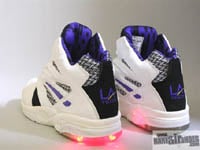
In the 1990s, some athletic shoes with flashing lights in the heels contained a mercury switch. Specifically, L.A. Gear brand “My Lil’ Lights” and “LA Light” children’s sneakers that were purchased before June 1994 contained a mercury tilt switch. Other manufacturers may have used mercury switches in their sneakers (pre-1997). The mercury switch was encased in the plastic sole of the sneaker, which lit-up as the child walked.
Purpose of the Mercury:
When a child wearing these sneakers walked and their heel hit the ground, the weight of their step would squeeze a small amount of liquid mercury encapsulated in the heel, completing a circuit and switching on the light in the sole of the sneaker. The heels of the sneakers would “light-up” with each step, thus the appeal to young children.
Potential Hazards:
The mercury contained in these old models of light-up sneakers is encased in three distinct layers of hard plastic; therefore, there is a low probability that there would be a mercury release from these shoes.
Recycling/Disposal:
Since these sneakers have not been manufactured or sold since 1997, most of them have already been disposed of. However, consumers that still have these specific “light-up” sneakers should dispose of them at local household hazardous waste facilities. Persons should first check with their local municipality to find out about the specific recycling and disposal options (including which products are accepted).
Statutes and Other Information:
When environmental regulators in Minnesota learned in 1994 that thousands of children were walking around with mercury switches in their sneakers, they decided to ban the sale of these shoes. L.A. Gear then settled a lawsuit with the state of Minnesota and agreed to pay $70,000 for the disposal of the roughly 20,000 pairs of sneakers it had sold in the state through a mail-in recycling program. After June 1994, L.A. Gear shifted to using a non-mercury switch, called an inertia switch, which consists of a metal spring connected to an electrical source on one end. This type of switch is still used in their sneakers today.
Mercury-containing “light-up” sneakers are no longer manufactured or sold in the U.S. The mercury switch originally used for the “light-up” effect has been replaced with a pressure switch.
Related Links:
Toys and Games
Description:
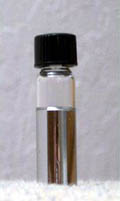
Different toys manufactured in the past have contained significant amounts of mercury either as liquid elemental mercury or mercury contained in a specific component. However, most of these vintage toys have been discontinued and are no longer available. A few examples are described below:
- Children’s Chemistry Sets: Pre-1960’s children’s chemistry sets often came with a vial of elemental mercury that children could use in various experiments. As a shiny liquid metal (liquid at room temperature) mercury was attractive to children, who would often just play with it in their hands or use it to clean coins.
- Mercury Maze Game: Also known as the Quicksilver Maze, this handheld game contained a bead of elemental mercury inside a plastic game board with a maze puzzle. The object of the game was to move this blob through a maze and to the center of the board where it would fall through a hole and return to the maze starting point.
- Bowling Green Puzzle: This is one of many handheld “dexterity” puzzles popular in the early-mid 1900s. As the elemental mercury is moved around in the plastic-encased game, it splits into individual beads. The object of this game was to fill as many holes (bowling pins) with the mercury beads as possible without letting any slip down the side (bowling alleyway).
Purpose of the Mercury:
The elemental mercury contained in vintage toys was used because of its unique properties. For example, the fact that elemental mercury may “split” and form different two distinct blobs increased the difficulty of directing the mercury through a maze, making the Mercury Maze Game more challenging.
Potential Hazards:
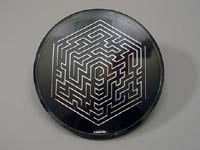
Vintage toys and games have the potential to release mercury. Depending on the type of chemistry set, the elemental mercury was contained in a plastic or glass vial which could easily break and result in a mercury spill. Similarly, the mercury contained in the Mercury Maze Game could be released if the game was dropped, cracked, or broken. If a leak or break occurs, persons should immediately contact their state environmental agency for instructions on proper clean-up and disposal. They should contact their public health department or poison control center if they have been exposed to the mercury.
Many of today’s toys that light up or make noise are still powered by mercury-containing button cell batteries. Even with rough play and a toy breaking apart, there is a low probability that there would be a mercury release from a button cell battery.
Recycling/Disposal:
Many states offer household hazardous waste collection programs for recycling and disposal of mercury-containing items, including toys. Some states and municipalities provide this service free of charge, while others require a small fee. Persons should first check with their local municipality to find out about the specific recycling and disposal options (including which products are accepted).
Because most button-cell batteries are not easily removed from the toys, consumers should dispose of the entire toy as hazardous waste and not attempt to remove the battery for separate disposal.
Statutes and Other Information:
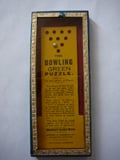
Vintage toys containing elemental mercury were discontinued long ago, and new chemistry sets do not contain mercury.
Note: modern toys with mercury-containing button-cell batteries are still manufactured and sold. Small toys, such as the ones found in cereal boxes, require small button-cell batteries, such as alkaline manganese, silver oxide, and/or zinc batteries, which contain a small amount of mercury. The mercury is found in the protective film of the battery cell and is used to prevent internal production of gas in batteries that could cause battery rupture. Another advantage of using these button-cell batteries in toys is that they last a long time.
Many states, including California, Minnesota, New Hampshire, Oregon, and Rhode Island, have instituted sales prohibitions or restrictions for mercury-containing toys under the category of novelty items. IMERC-member states define a novelty as a “mercury-added product intended mainly for personal or household enjoyment or adornment, including items intended for use as practical jokes, figurines, adornments, toys, games, cards, ornaments, yard statues and figures, candles, jewelry, holiday decorations, and footwear and other items of apparel.” However, the exact legal definition and effective date for each of the states’ phase-out of mercury-added novelty products differs. Most of these states do allow the manufacturers to apply for an exemption, which, if approved, would enable them to legally sell these products in the state after the effective phase-out date.
Other states, including Illinois, Louisiana, New York, Ohio, Vermont, Washington, and Wisconsin prohibit the sale of most mercury-added novelty items, but include a blanket exemption for novelties in which the only mercury included is part of the button-cell battery. Connecticut, Indiana, and New Hampshire also include an exemption to their mercury novelty product sales ban but specify that the exemption applies to removable button-cell batteries only.
Maine will draft a report to their legislature January 1, 2009 to determine if a slated ban on mercury-added button cell batteries can go into effect on January 1, 2011.
General References
The links below are general references that provide information pertaining to all types of mercury-added novelty products:
Mercury Product Phase-outs, Sales Prohibitions, and Exemptions:
http://www.newmoa.org/prevention/mercury/imerc/banphaseout.cfm
Spill Clean-up Guidance:
http://www.mass.gov/eea/agencies/massdep/toxics/sources/cleaning-up-elemental-mercury-spills.html
